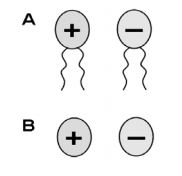Plant Kingdom
- In Ulothrix/Spirogyra, reduction division (meiosis) occurs at the time of
-
View Hint View Answer Discuss in Forum
Plant body of Ulothrix and Spirogyra is gametophyte (haploid), they produce zoogametes(n) which fuse to form zygospore (2n) diploid, which is a resting spore. Under favourable condition zygospore undergoes reductional division or meiosis to produce zoospores which give rise to new plant.
Correct Option: C
Plant body of Ulothrix and Spirogyra is gametophyte (haploid), they produce zoogametes(n) which fuse to form zygospore (2n) diploid, which is a resting spore. Under favourable condition zygospore undergoes reductional division or meiosis to produce zoospores which give rise to new plant.
- Chloroplast of Chlamydomonas is
-
View Hint View Answer Discuss in Forum
Shape and number of chloroplast in different members of algae is different
Chlamydomonas – cup shaped, 1/cell
Zygnema – Stellate, 2/cell
Spirogyra – Spiral, 1/ cell
Ulothrix – Collar shaped, 1/cellCorrect Option: B
Shape and number of chloroplast in different members of algae is different
Chlamydomonas – cup shaped, 1/cell
Zygnema – Stellate, 2/cell
Spirogyra – Spiral, 1/ cell
Ulothrix – Collar shaped, 1/cell
- The common mode of sexual reproduction in Chlamydomonas is
-
View Hint View Answer Discuss in Forum
In Chlamydomonas, sexual reproduction takes place through :
1. Isogamy : Fusion of 2 similar gametes.
2. Anisogamy : Fusion between morphologically similar but physiologically different gametes.
3. Oogamy : Fusion between two dissimilar gametes.
4. Hologamy : Fusion of two young cells. Most common mode is isogamy.Correct Option: A
In Chlamydomonas, sexual reproduction takes place through :
1. Isogamy : Fusion of 2 similar gametes.
2. Anisogamy : Fusion between morphologically similar but physiologically different gametes.
3. Oogamy : Fusion between two dissimilar gametes.
4. Hologamy : Fusion of two young cells. Most common mode is isogamy.
- Sexual reproduction involving fusion of two cells in Chlamydomonas is
-
View Hint View Answer Discuss in Forum
Isogamy refers to a form of sexual reproduction involving gametes of the same size. Since both gametes look alike, they cannot be classified as “male” or “female.” Instead, organisms undergoing isogamy are said to have different mating types, most commonly noted as “+” and “–” strains. Fertilization occurs when “+” and “–” strain gametes fuse to form a zygote. There are several types of isogamy. Both gametes may be flagellated and thus motile. This type mating occurs in algae such as Chlamydomonas.

A. Isogamy of motile cells
B. Isogamy of non-motile cellsCorrect Option: A
Isogamy refers to a form of sexual reproduction involving gametes of the same size. Since both gametes look alike, they cannot be classified as “male” or “female.” Instead, organisms undergoing isogamy are said to have different mating types, most commonly noted as “+” and “–” strains. Fertilization occurs when “+” and “–” strain gametes fuse to form a zygote. There are several types of isogamy. Both gametes may be flagellated and thus motile. This type mating occurs in algae such as Chlamydomonas.

A. Isogamy of motile cells
B. Isogamy of non-motile cells
- In Chlorophyceae, sexual reproduction occurs by
-
View Hint View Answer Discuss in Forum
In chlorophyceae, sexual reproduction takes place by all the three processes
1. Isogamy – Fusion of morphologically and physiologically similar gametes.
2. Anisogamy – Morphologically similar but physiologically dissimilar gametes.
3. Oogamy – Fusing gametes are dissimilar in all respect.Correct Option: B
In chlorophyceae, sexual reproduction takes place by all the three processes
1. Isogamy – Fusion of morphologically and physiologically similar gametes.
2. Anisogamy – Morphologically similar but physiologically dissimilar gametes.
3. Oogamy – Fusing gametes are dissimilar in all respect.

